初中英语状语从句
- 格式:doc
- 大小:102.50 KB
- 文档页数:10
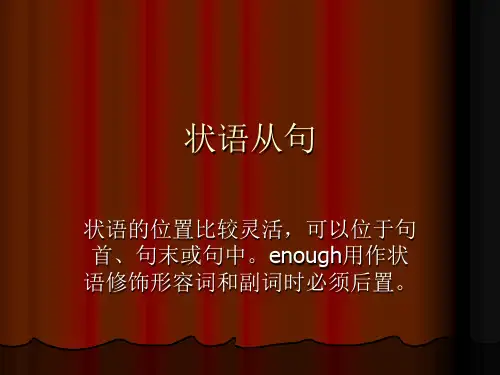

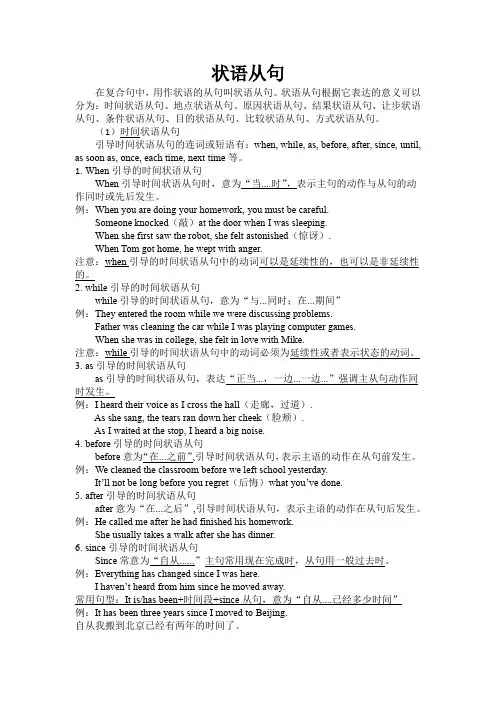
状语从句在复合句中,用作状语的从句叫状语从句。
状语从句根据它表达的意义可以分为:时间状语从句、地点状语从句、原因状语从句、结果状语从句、让步状语从句、条件状语从句、目的状语从句、比较状语从句、方式状语从句。
(1)时间状语从句引导时间状语从句的连词或短语有:when, while, as, before, after, since, until, as soon as, once, each time, next time等。
1.When引导的时间状语从句When引导时间状语从句时,意为“当....时”,表示主句的动作与从句的动作同时或先后发生。
例:When you are doing your homework, you must be careful.Someone knocked(敲)at the door when I was sleeping.When she first saw the robot, she felt astonished(惊讶).When Tom got home, he wept with anger.注意:when引导的时间状语从句中的动词可以是延续性的,也可以是非延续性的。
2.while引导的时间状语从句while引导的时间状语从句,意为“与...同时;在...期间”例:They entered the room while we were discussing problems.Father was cleaning the car while I was playing computer games.When she was in college, she felt in love with Mike.注意:while引导的时间状语从句中的动词必须为延续性或者表示状态的动词。
3.as引导的时间状语从句as引导的时间状语从句,表达“正当...,一边...一边...”强调主从句动作同时发生。

初中英语语法之状语从句类型及考点讲义状语从句概念解析状语从句指句子用作状语时,起副词作用的句子,可以修饰谓语、非谓语动词、定语、状语或整个句子,可分为时间、地点、原因、条件、目的、结果、让步、方式和比较等从句,是英语复合句学习的一个重点,在各类考试中都会经常出现,这次就来给大家讲解一下什么是状语从句。
1. 时间状语从句:常用引导词:when, as, while, as soon as, before, after, since , till, until特殊引导词:the minute, the moment, the second, every time, the day,the instant, immediately , directly, no sooner … than, hardly …when, scarcely … when instantlyI ran into the classroom as soon as the bell rang.2. 地点状语从句:常用引导词:where特殊引导词:wherever, anywhere, everywhereWherever the sea is , you will find seamen.3. 原因状语从句:常用引导词:because=in that, since=now that, as, for特殊引导词:seeing that, now that, in that, considering that, given thatI 'm late because I didn't caught the bus.4. 目的状语从句:常用引导词:so that, in order that特殊引导词: for fear that(唯恐/生怕),in the hope that, for the purpose that, to the end thatYou should book the hotel in advance so that the travel will be more easy.5.结果状语从句:常用引导词:so … that, such … that特殊引导词:such that, to the degree that, to the extent that, to such a degree thatHe is so young that he can't have meal by himself.6. 条件状语从句:常用引导词:if, unless,特殊引导词:as/so long as(只要), only if, providing/provided that(倘若), supposing that(倘若), in case that(以防), on condition thatYou can go to London as long as you have passport.7.让步状语从句:常用引导词:though, although, even if, even though特殊引导词: as(用在让步状语从句中必须要倒装),while,no matter …, in spite of the fact that, whatever, whoever, wherever, whenever, however, whichever, as if=as thoughThough we are old, we still can do these by ourselves.8. 比较状语从句:常用引导词:as(同级比较), than(不同程度的比较)特殊引导词:the more …the more …; just as …,so…,no … more than; not A so much as BShe is as pretty as her mother.9. 方式状语从句:常用引导词:as, as if, how特殊引导词:the wayHe didn't so it the way his brother did.辨析:while,when,as三者引导的时间状语从句时间状语从句算是状语从句中最简单的一类,也是我们日常生活交流中最常用的一类,虽然难度不大,但引导词也不少,仍然有不少同学会弄混那几个常见引导词的用法,这次就为大家带来as,when,while这几个词的辨析方法,一起看看吧。

初中英语知识点归纳状语从句的分类和用法状语从句是英语语法中重要的一部分,它用来修饰主句的动作或描述情况的,在句子中起着状语的作用。
状语从句分为时间状语从句、条件状语从句、原因状语从句、目的状语从句、结果状语从句、方式状语从句和比较状语从句等。
下面将对初中英语中常见的状语从句分类和用法进行归纳。
一、时间状语从句时间状语从句用来表示动作或事件发生的时间,包括连词when (当...时候),while (在...时候),before (在...之前),after (在...之后),as (当),since (自从),until (直到)等。
时间状语从句一般放在主句之前或者之后。
例如:- When I was young, I used to play soccer with my friends. (当我年轻的时候,我常常和朋友们踢足球。
)- After she finished her homework, she went to bed. (她完成作业之后,去睡觉了。
)二、条件状语从句条件状语从句用来表示主句动作的条件或前提,包括连词if (如果),unless (除非),in case (以防),as long as (只要),provided/providing (只要)等。
条件状语从句一般放在主句之前。
例如:- If it rains tomorrow, we will stay at home. (如果明天下雨,我们就在家呆着。
)- Unless you work hard, you won't pass the exam. (除非你努力学习,否则你就不能通过考试。
)三、原因状语从句原因状语从句用来表示主句动作或情况的原因,包括连词because (因为),as (因为),since (因为),for (因为),now that (既然)等。
原因状语从句一般放在主句之前。
例如:- Because it was raining, we stayed at home. (因为下雨,我们呆在家里。
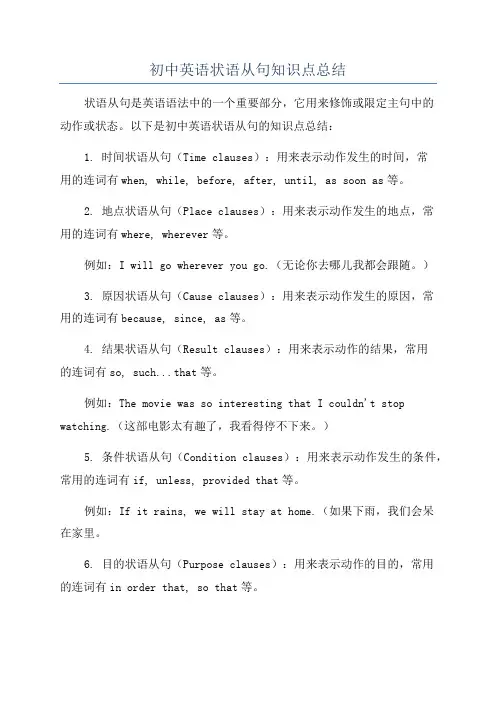
初中英语状语从句知识点总结状语从句是英语语法中的一个重要部分,它用来修饰或限定主句中的动作或状态。
以下是初中英语状语从句的知识点总结:1. 时间状语从句(Time clauses):用来表示动作发生的时间,常用的连词有when, while, before, after, until, as soon as等。
2. 地点状语从句(Place clauses):用来表示动作发生的地点,常用的连词有where, wherever等。
例如:I will go wherever you go.(无论你去哪儿我都会跟随。
)3. 原因状语从句(Cause clauses):用来表示动作发生的原因,常用的连词有because, since, as等。
4. 结果状语从句(Result clauses):用来表示动作的结果,常用的连词有so, such...that等。
例如:The movie was so interesting that I couldn't stop watching.(这部电影太有趣了,我看得停不下来。
)5. 条件状语从句(Condition clauses):用来表示动作发生的条件,常用的连词有if, unless, provided that等。
例如:If it rains, we will stay at home.(如果下雨,我们会呆在家里。
6. 目的状语从句(Purpose clauses):用来表示动作的目的,常用的连词有in order that, so that等。
例如:I bought a new notebook so that I can take notes in class.(我买了一个新笔记本,这样我可以在课堂上记笔记。
)7. 方式状语从句(Manner clauses):用来表示动作发生的方式,常用的连词有as, as if, as though等。
例如:He speaks as if he knows everything.(他说话的样子就像他什么都知道。

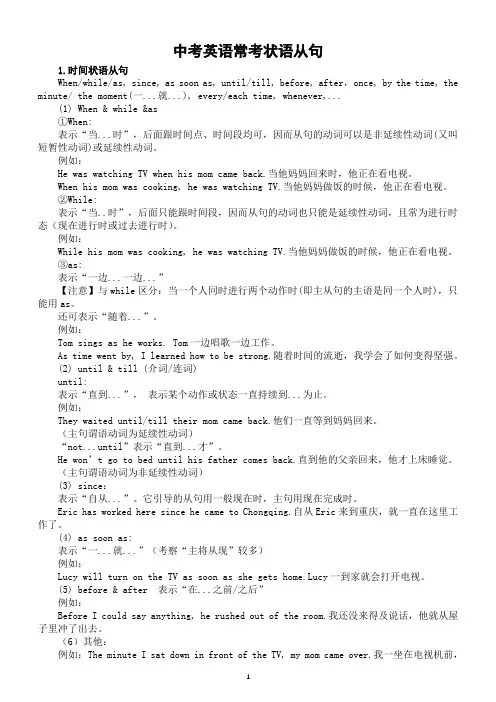
中考英语常考状语从句1.时间状语从句When/while/as, since, as soon as, until/till, before, after,once, by the time, the minute/ the moment(一...就...), every/each time, whenever,...(1) When & while &as①When:表示“当...时”,后面跟时间点、时间段均可,因而从句的动词可以是非延续性动词(又叫短暂性动词)或延续性动词。
例如:He was watching TV when his mom came back.当他妈妈回来时,他正在看电视。
When his mom was cooking, he was watching TV.当他妈妈做饭的时候,他正在看电视。
②While:表示“当..时”,后面只能跟时间段,因而从句的动词也只能是延续性动词,且常为进行时态(现在进行时或过去进行时)。
例如:While his mom was cooking, he was watching TV.当他妈妈做饭的时候,他正在看电视。
③as:表示“一边...一边...”【注意】与while区分:当一个人同时进行两个动作时(即主从句的主语是同一个人时),只能用as。
还可表示“随着...”。
例如:Tom sings as he works. Tom一边唱歌一边工作。
As time went by, I learned how to be strong.随着时间的流逝,我学会了如何变得坚强。
(2) until & till (介词/连词)until:表示“直到...”,表示某个动作或状态一直持续到...为止。
例如:They waited until/till their mom came back.他们一直等到妈妈回来。
(主句谓语动词为延续性动词)“not...until”表示“直到...才”。
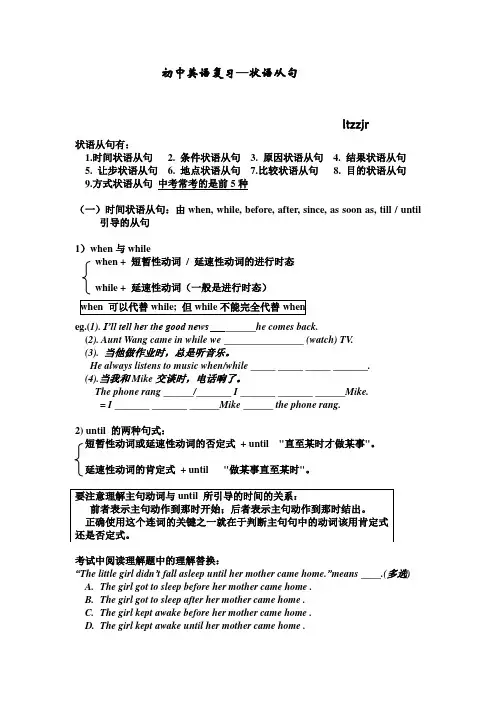
初中英语复习—状语从句ltzzjr状语从句有:1.时间状语从句2. 条件状语从句3. 原因状语从句4. 结果状语从句5. 让步状语从句6. 地点状语从句7.比较状语从句8. 目的状语从句9.方式状语从句中考常考的是前5种(一)时间状语从句:由when, while, before, after, since, as soon as, till / until 引导的从句1)when与whilewhen + 短暂性动词/ 延速性动词的进行时态while + 延速性动词(一般是进行时态)eg.(1). I’ll tell her the good news _________he comes back.(2). Aunt Wang came in while we ________________ (watch) TV.(3). 当他做作业时,总是听音乐。
He always listens to music when/while _____ _____ _____ _______.(4).当我和Mike交谈时,电话响了。
The phone rang ______/_______ I _______ _______ ______Mike.= I _______ _______ ______Mike ______ the phone rang.2) until 的两种句式:短暂性动词或延速性动词的否定式+ until "直至某时才做某事"。
延速性动词的肯定式+ until "做某事直至某时"。
考试中阅读理解题中的理解替换:“The little girl didn’t fall asleep until her mother came home.”means ____.(多选)A.The girl got to sleep before her mother came home .B.The girl got to sleep after her mother came home .C.The girl kept awake before her mother came home .D.The girl kept awake until her mother came home .(1)直到他妈妈回来,我们才离开。
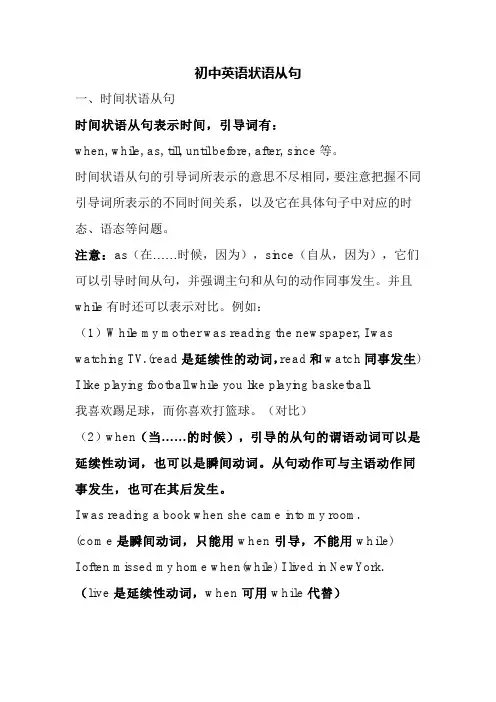
初中英语状语从句一、时间状语从句时间状语从句表示时间,引导词有:when, while, as, till, until before, after, since等。
时间状语从句的引导词所表示的意思不尽相同,要注意把握不同引导词所表示的不同时间关系,以及它在具体句子中对应的时态、语态等问题。
注意:as(在……时候,因为),since(自从,因为),它们可以引导时间从句,并强调主句和从句的动作同事发生。
并且while有时还可以表示对比。
例如:(1)While my mother was reading the newspaper, I was watching TV.(read是延续性的动词,read和watch同事发生) I like playing football while you like playing basketball.我喜欢踢足球,而你喜欢打篮球。
(对比)(2)when(当……的时候),引导的从句的谓语动词可以是延续性动词,也可以是瞬间动词。
从句动作可与主语动作同事发生,也可在其后发生。
I was reading a book when she came into my room.(come是瞬间动词,只能用when引导,不能用while)I often missed my home when(while) I lived in NewYork. (live是延续性动词,when可用while代替)(3)when和while的区别还在于:while引导的时间状语从句多用于进行时态,而when引导的时间状语从句多用于一般时态。
While they were talking, the bell rang.正在他们谈话的时候,上课铃响了。
(4)as译作“一边……一边”、“随着……”,侧重主句和从句的动作同时发生。
有时可与when,while通用。
We always sing as we walk.我们总是边走边唱。

初中英语九种状语从句归纳总结一、时间状语从句(Time adverbial clauses)时间状语从句用来表示一个动作或事件发生的时间。
常见的引导词有:when(当…时候)、while(当…的时候)、as(当…时候)、before (在…之前)、after(在…之后)、since(自从…以来)、until(直到…为止)、as soon as(一…就…)、whenever(无论何时)等等。
例如:- She likes to listen to music while she is cooking.(她喜欢一边做饭一边听音乐。
)- He went to bed after he finished his homework.(他做完作业后去睡觉了。
)二、地点状语从句(Place adverbial clauses)地点状语从句用来表示一个动作或事件发生的地点。
常见的引导词有:where(在哪里)、wherever(无论在哪里)等等。
例如:- I will meet you at the place where we first met.(我会在我们第一次见面的地方见你。
)三、方式状语从句(Manner adverbial clauses)方式状语从句用来表示一个动作或事件发生的方式。
常见的引导词有:as(以…方式)、as if(好像)、as though(好像)等等。
例如:- She sang the song as if she was performing on stage.(她唱歌的时候好像在舞台上表演一样。
)- He spoke English as though he was a native speaker.(他讲英语好像是母语一样。
)四、原因状语从句(Reason adverbial clauses)原因状语从句用来表示一个动作或事件发生的原因。
常见的引导词有:because(因为)、as(因为)、since(因为)、as long as(只要)等等。
初中英语语法状语从句初中英语语法状语从句1状语从句在复合句中,修饰主句中的动词、形容词或副词等的从句叫状语从句。
状语从句根据它表达的意思可分为时间、地点、原因、目的、结果、让步、比较(或方式)和条件等类。
1.时间状语从句引导连词有when,while,till,not…until,since,after ,before ,as soon asThe bus won’t start until everybody gets on.公共汽车直到每人都上车为止,才开动。
When he knocked at the door I was cooking.当他敲门时,我正在煮饭。
Last night before he came back home, his wife had already cooked dinner and waited for 2 hours.昨天晚上在他回到家之前,他的妻子已经做好晚饭足足等了他两小时之久。
After I went to church, I went shopping.2.地点状语从句地点状语从句通常由where, wherever 引导。
Where there is a will, there is a way. 哪里有志向,哪里就有出路。
有志者事竟成。
Where there is a life, there is a hope. 哪里有生命,哪里就有希望。
留得青山在,不怕没柴烧。
Wherever you go, whatever you do, I will be right here waiting for you.不管你去哪里,不管你做什么,我都会在此守侯你。
3.原因状语从句引导连词有because,as, since。
He didn′t see the film because he had seen it.他没有看那部电影,因为他已经看过了。
They couldn’t get on the train,for it was too crowed.比较:because, since, as和for1)because语势最强,用来说明人所不知的原因,回答why提出的问题。
初中英语状语从句【考点直击】1. 时间状语从句2. 条件状语从句3. 原因状语从句4. 结果状语从句5. 比较状语从句6. 目的状语从句7. 让步状语从句8. 地点状语从句【名师点睛】用来修饰主句中的动词,副词和形容词的从句叫状语从句。
根据其含义状语从句可分为时间状语从句,地点状语从句,条件状语从句,原因状语从句,结果状语从句,比较状语从句,目的状语从句,让步状语从句。
1. 时间状语从句(1)时间状语从句常用when, as, whil e, before, after, since, till, until, as soon as等连词来引导。
例如:It was raining hard when got to school yesterday.Whil e he was doing his homework, the tel ephone rang.As he walked al ong the lake, he sang happily.He had l earned a littl e Chinese before he came to China.After he finished middl e school, he went to work in a factory.(2)在时间状语从句里,通常不用将来时态,用现在时态表示将来的动作或状态。
例如:I’ll ring you up as soon as I get to New York.I will tell him everything when he comes back.He won’t believe it until he sees it with his own eyes.(3)在带有till或until引导的时间状语从句的主从复合句里,如果主句用肯定式,其含义是“一直到……时”,谓语动词只能用延续性动词。
如果主句用否定式,其含义是“直到……才……”, “在……以前不……”, 谓语动词可用瞬间动词。
例如:The young man read till the light went out.Let’s wait until the rain stops.We won’t start until Bob comes.Don’t get off until the bus stops.2. 条件状语从句(1)条件状语从句通常由if, unl ess引导。
例如:What shall we do if it snows tomorrow?Don’t l eave the buil ding unl ess I tell you to.(2)在条件状语从句里,谓语动词通常用现在时态表示将来的动作或状态。
例如:I’ll help you with your English if am free tomorrow.He won’t be late unl ess he is ill.(3)“祈使句+ and (or)+ 陈述句”在意思上相当于一个带有条件状语从句的复合句。
例如:Hurry up, or you’ll be late.=If you don’t hurry up, you’ll be late.Study hard and you will pass the exam.=If you study hard, you will pass the exam.3. 原因状语从句(1)原因状语从句通常由because, since, as引导。
例如:He didn’t come to school because he was ill.As it is raining, we shall not go the zoo.Since you can’t answer the question, I’ll ask someone else.(2)because表示直接原因,语气最强。
Because引导的原因状语从句多放在主句之后。
回答由why提出的问题,只能用because。
As和since语气较弱,一般用来表示明显的原因。
由as和since引导的原因状语从居多放在句首。
例如:------Why aren’t going there?------Because I don’t want to.As he has no car, he can’t get there easily.Since we have no money, we can’t buy it.(3)because和so不能同用在一个句子里。
4. 结果状语从句(1)结果状语从句由so…that, such…that, so that引导。
例如:He is so poor that he can’t buy a bike for his son.She is such a good teacher that everybody likes her.My pencil fell under the desk, so that I coul dn’t see it.(2)so…that语such...that可以互换。
例如:在由so...that引导的结果状语从句中,so是副词,与形容词连用。
其结构是: “...so + 形容词(副词)+ that + 从句”。
例如:He was so glad that he coul dn’t say a word.The hall is so big that it can hol d 2,000 peopl e.Mother lives so far away that we hardly ever see her.在由such…that引导的结果状语从句中,such是形容词,它修饰的可以是单数或复数可数名词,也可以是不可数名词;名词前面可以带形容词,也可不带。
如果是单数可数名词,前面需加不定冠词a或an。
例如:It was such a hot day that nobody wanted to do anything.He had such l ong arms that he coul d almost touch the ceiling.He made such rapid progress that he did very well in the mid-term.有时上述两种结构是可以互换的。
例如:It was such a wonderful film that all of us wanted to see it again.=The film was so wonderful that all of us wanted to see it again.It is such an important match that nobody wants to miss it.=The match is so important that nobody wants to miss it.(3)如果名词前由many, much, littl e, few等词修饰时,只能用so, 不用such。
例如:Soon there were so many d eer that they ate up all the wil d roses.He has so littl e time that he can’t go to the cinema with you.5. 比较状语从句比较状语从句通常由as…as, 比较级+ than…等连词引导。
例如:Tom runs faster than John does.This classroom is as big as that one.6. 目的状语从句(1)目的状语从句通常由so that, in order that引导。
例如:We started early so that we coul d catch the first train.He studies hard so that he coul d work better in the future.We used the computer in order that we might save time.(2)so that既可引导目的状语从句,又可引导结果状语从句。
区别这两种从句的办法有两个:1)目的状语从句里往往带有情态动词can, coul d, may, might等。
2)从意思上看,目的状语从句往往表示的目的很明确。
例如:Speak cl early so that they may understand you. (目的状语从句)Jack is badly ill so that he has to rest. (结果状语从句)7. 让步状语从句(1)让步状语从句通常由although, though等连词引导。
例如:Though he is young, he knows a l ot.Although I am tired, I must go on working.(2)although(though)不能用在同一个句子中。
例如:我们不能说:Though it was raining hard, but he still went out.应该说:Though it was raining hard, he still went out.或It was raining hard, but he still went out.8. 地点状语从句地点状语从句常常由where来引导。
例如:Go where you like.Where there is a will, there is a way.【实例解析】1. (2004年北京市海淀区中考试题)You will stay healthy _______ you do more exercise, such as running and walking.A. ifB. howC. beforeD. where答案:A。
该题考查的是引导状语从句的从属连词的选择。
从意思上看,从句应是一个条件状语从句,在这四个选项中只有if能引导条件状语从句,所以选A。
2. (2004年江西省中考试题)---Shall we go on working?---Yes, _________ I prefer to have a rest.A. whenB. ifC. becauseD. though答案:D。
该题考查的是引导状语从句的从属连词的选择。